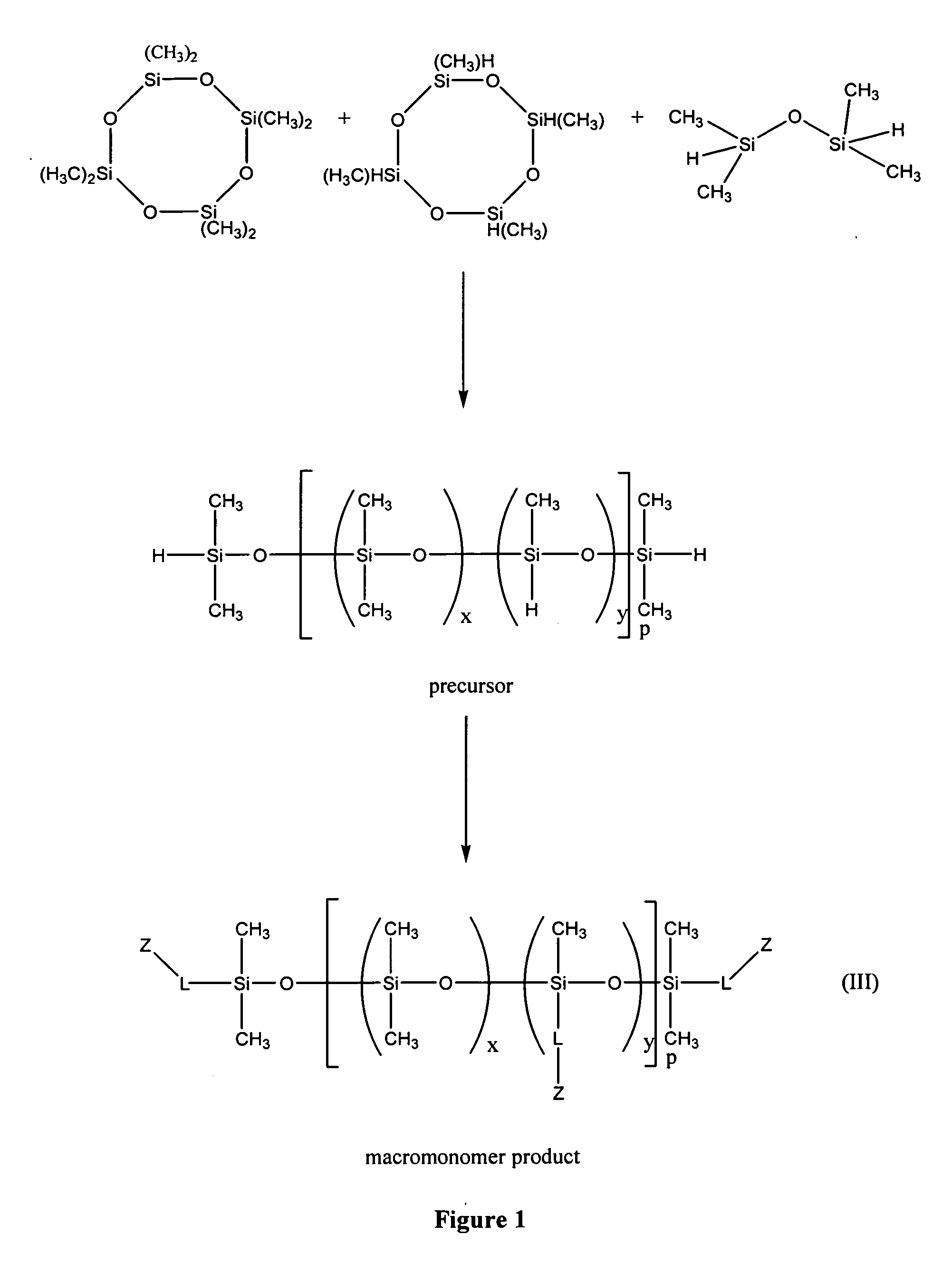Biomedical compositions
a biomedical composition and macromonomer technology, applied in the field of ethylenically unsaturated macromonomers, to achieve the effects of reducing “extractables”, increasing cross-linking, and increasing the probability of each polymer chain being incorporated
- Summary
- Abstract
- Description
- Claims
- Application Information
AI Technical Summary
Benefits of technology
Problems solved by technology
Method used
Image
Examples
example 1
[0071] This example illustrates the preparation of methacryloxypropyl terminated 1.2%-(poly-methylmethacryloxypropylsiloxane) (dimethyl siloxane) copolymer.
[0072] Preparation of Stock Solutions:
[0073] A stock solution of tetramethyldisiloxane (IS) was prepared by dissolving 8.00 g of tetumethyldisiloxane in 353.08 g of octamethylcyclotetrasiloxane.
[0074] A stock solution of 1,3,5,7-tetramethylcyclotetrasiloxane (TMCTS) was prepared by dissolving 3.618 g of 1,3,5,7-tetramethylcyclotetrasiloxane in 46.2367 g of octamethylcyclotetrasiloxane.
[0075] Preparation of Copolymer Precursor:
[0076] 5 g of the tetramethyldisiloxane stock solution, 5 g, of the 1,3,5,7-tetramethylcyclotetrasiloxane stock solution and 40.00 g of octadecylcyclotetrasiloxane were mixed in a round bottom flask under an inert atmosphere. To the mixture was added 50 mL of dry toluene followed by 0.125 g of trifluoromethanesulfonic acid. The reaction mixture was allowed to stir at room temperature for 3 days. 10.0 g ...
example 2
[0078] This example illustrates the physical properties of the cured crosslinkable siloxane macromolecule in Example 1. 0.4 mL of the siloxane macromolecule prepared in Example 1 was poured into a 20 mm diameter polypropylene mould and pressed flat with a polypropylene top plate. The sample was irradiated with 4 mW / cm-2 blue light (wavelength range 420-460 nm) for 40 minutes to give a clear colourless disc. The Young's modulus of the cured polymer was measured by MFR as being 27 kPa.
example 3
[0079] This example illustrates the preparation of acrylamide terminated 0.5%-(poly-acrylamide substituted siloxane) (dimethyl siloxane) copolymer 11.0 g of the TMDS stock solution mentioned in Example 1, 5.5555 g of the 1,3,5,7-TMCTS stock solution mentioned in Example 1 and 84.4445 g of octamethylcyclotetrasiloxane were mixed in a round bottom flask under an inert atmosphere. To the mixture was added 100 ml of dry toluene followed by 0.250 g of trifluoromethanesulfonic acid. The reaction mixture was allowed to stir at room temperature for 4 days. 20.0 g of anhydrous sodium carbonate was then added and the mixture stirred overnight, before the sodium carbonate was filtered off. The toluene solution was poured into an excess of ethanol to precipitate the siloxane copolymer which was then transferred to a kugelrohr distillation apparatus and stripped of low molecular weight species to give the poly-methylhydrosiloxane-dimethylsiloxane copolymer as a clear colourless oil (viscosity 30...
PUM
| Property | Measurement | Unit |
|---|---|---|
| specific gravity | aaaaa | aaaaa |
| refractive index | aaaaa | aaaaa |
| length | aaaaa | aaaaa |
Abstract
Description
Claims
Application Information
 Login to View More
Login to View More - R&D
- Intellectual Property
- Life Sciences
- Materials
- Tech Scout
- Unparalleled Data Quality
- Higher Quality Content
- 60% Fewer Hallucinations
Browse by: Latest US Patents, China's latest patents, Technical Efficacy Thesaurus, Application Domain, Technology Topic, Popular Technical Reports.
© 2025 PatSnap. All rights reserved.Legal|Privacy policy|Modern Slavery Act Transparency Statement|Sitemap|About US| Contact US: help@patsnap.com



